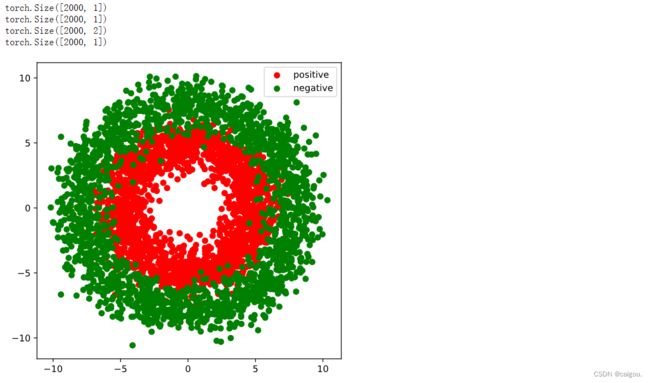DNN二分类模型
import os
import datetime
#打印时间
def printbar():
nowtime = datetime.datetime.now().strftime('%Y-%m-%d %H:%M:%S')
print("\n"+"=========="*8 + "%s"%nowtime)
#mac系统上pytorch和matplotlib在jupyter中同时跑需要更改环境变量
os.environ["KMP_DUPLICATE_LIB_OK"]="TRUE"
printbar()准备数据:
import numpy as np
import pandas as pd
from matplotlib import pyplot as plt
import torch
from torch import nn
%matplotlib inline
%config InlineBackend.figure_format = 'svg'
#正负样本数量
n_positive,n_negative = 2000,2000
#生成正样本, 小圆环分布 torch.normal 是 PyTorch 的一个函数,用于根据正态分布(高斯分布)生成随机数张量
r_p = 5.0 + torch.normal(0.0,1.0,size = [n_positive,1]) # 0.0表示均值,1.0表示标准差的正态分布, torch.normal(mean, std, size)
#print(r_p.shape)
theta_p = 2*np.pi*torch.rand([n_positive,1]) #torch.rand 是 PyTorch 中用于生成均匀分布(uniform distribution)的随机数张量的函数
# torch.rand()生成0到之间的均匀分布的随机数,torch.normal生成指定均值和标准差的正太分布的随机数
#print(theta_p.shape) theta_p形状是[2000,1],每个数范围是0到2Π,cos(theta_p)范围是余弦函数一个周期的图像,*r_p表示(rcos角度,rsin角度)
Xp = torch.cat([r_p*torch.cos(theta_p),r_p*torch.sin(theta_p)],axis = 1)
# torch.cat 拼接两个生成一个二维张量,axis = 1表示在axis = 1方向上拼接,就是Xp(x,y)坐标,x,y都是-5到5之内的数,Xp的每一行表示一个点
print(Xp.shape)
Yp = torch.ones_like(r_p)
print(Yp.shape)
#生成负样本, 大圆环分布
r_n = 8.0 + torch.normal(0.0,1.0,size = [n_negative,1])
theta_n = 2*np.pi*torch.rand([n_negative,1])
Xn = torch.cat([r_n*torch.cos(theta_n),r_n*torch.sin(theta_n)],axis = 1)
Yn = torch.zeros_like(r_n)
#汇总样本
X = torch.cat([Xp,Xn],axis = 0) # 正负样本所有点进行拼接。在0维度上,也就是把两个n行,每行一系列点的张量在行上往下拼接
Y = torch.cat([Yp,Yn],axis = 0) # Yp,Yn表示正负样本的标签,也就是二分类的类别标签而已
#可视化
plt.figure(figsize = (6,6))
plt.scatter(Xp[:,0].numpy(),Xp[:,1].numpy(),c = "r")
plt.scatter(Xn[:,0].numpy(),Xn[:,1].numpy(),c = "g")
plt.legend(["positive","negative"]);
# 构建数据管道迭代器
def data_iter(features, labels, batch_size=8):
num_examples = len(features) #样本总个数,就是点的总个数 len()函数来获取列表的长度,也就是样本的数量
indices = list(range(num_examples)) # 转换成列表类型 range(num_examples)生成一个有序数组,转成列表形式,
# Python中,range()函数生成的整数序列范围为 [start, end) (包左不包右)
# torch.range()函数生成的整数序列范围为 [start, end] (包左包右)
np.random.shuffle(indices) #样本的读取顺序是随机的,打乱样本点的索引
for i in range(0, num_examples, batch_size):
# 列表切片,根据样本个数长度范围内的随机列表生成一个批次的列表索引
indexs = torch.LongTensor(indices[i: min(i + batch_size, num_examples)])
# features输入的是X,[4000,2]的4000个点的张量格式,
# torch.index_select是PyTorch中的一个函数,其主要用途是允许您在特定维度上选择索引,从而获取所需的张量子集2。
yield features.index_select(0, indexs), labels.index_select(0, indexs) # 取出总样本中batch_size个数据
# 测试数据管道效果
batch_size = 8
# X,Y 是正负样本也就是两个类别拼接后的张量,X是点,Y是点的类别
(features,labels) = next(data_iter(X,Y,batch_size))
print(features)
print(labels)
class DNNModel(nn.Module):
def __init__(self):
super(DNNModel, self).__init__()
self.w1 = nn.Parameter(torch.randn(2,4)) # 两行四列
self.b1 = nn.Parameter(torch.zeros(1,4)) # 偏置全是0
self.w2 = nn.Parameter(torch.randn(4,8))
self.b2 = nn.Parameter(torch.zeros(1,8))
self.w3 = nn.Parameter(torch.randn(8,1))
self.b3 = nn.Parameter(torch.zeros(1,1)) # 最后预测结果形状[8,1] 是8个数的大小,就是这组权重偏置预测出来的结果
# 正向传播
def forward(self,x):
x = torch.relu([email protected] + self.b1)
x = torch.relu([email protected] + self.b2)
y = torch.sigmoid([email protected] + self.b3)
return y # y就是预测
# 损失函数(二元交叉熵)
def loss_fn(self,y_pred,y_true):
#将预测值限制在1e-7以上, 1- (1e-7)以下,避免log(0)错误
eps = 1e-7
y_pred = torch.clamp(y_pred,eps,1.0-eps)
bce = - y_true*torch.log(y_pred) - (1-y_true)*torch.log(1-y_pred)
return torch.mean(bce)
# 评估指标(准确率)
def metric_fn(self,y_pred,y_true):
y_pred = torch.where(y_pred>0.5,torch.ones_like(y_pred,dtype = torch.float32),
torch.zeros_like(y_pred,dtype = torch.float32))
acc = torch.mean(1-torch.abs(y_true-y_pred))
return acc
model = DNNModel()
# 测试模型结构
batch_size = 10
(features,labels) = next(data_iter(X,Y,batch_size))
predictions = model(features)
loss = model.loss_fn(labels,predictions)
metric = model.metric_fn(labels,predictions)
print("init loss:", loss.item())
print("init metric:", metric.item())
训练模型
def train_step(model, features, labels):
# 正向传播求损失
predictions = model.forward(features)
loss = model.loss_fn(predictions,labels)
metric = model.metric_fn(predictions,labels)
# 反向传播求梯度
loss.backward()
# 梯度下降法更新参数
for param in model.parameters():
#注意是对param.data进行重新赋值,避免此处操作引起梯度记录
param.data = (param.data - 0.01*param.grad.data)
# 梯度清零
model.zero_grad()
return loss.item(),metric.item()
def train_model(model,epochs):
for epoch in range(1,epochs+1):
loss_list,metric_list = [],[]
for features, labels in data_iter(X,Y,20):
# 分批训练
lossi,metrici = train_step(model,features,labels)
loss_list.append(lossi)
metric_list.append(metrici)
loss = np.mean(loss_list)
metric = np.mean(metric_list)
if epoch%10==0:
printbar() # 最开始定义的打印时间的函数
print("epoch =",epoch,"loss = ",loss,"metric = ",metric)
train_model(model,epochs = 100)
# 结果可视化
fig, (ax1,ax2) = plt.subplots(nrows=1,ncols=2,figsize = (12,5))
ax1.scatter(Xp[:,0],Xp[:,1], c="r")
ax1.scatter(Xn[:,0],Xn[:,1],c = "g")
ax1.legend(["positive","negative"]);
ax1.set_title("y_true");
Xp_pred = X[torch.squeeze(model.forward(X)>=0.5)]
Xn_pred = X[torch.squeeze(model.forward(X)<0.5)]
ax2.scatter(Xp_pred[:,0],Xp_pred[:,1],c = "r")
ax2.scatter(Xn_pred[:,0],Xn_pred[:,1],c = "g")
ax2.legend(["positive","negative"]);
ax2.set_title("y_pred");


